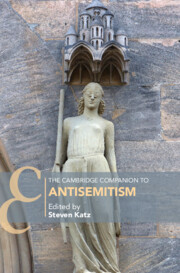Book contents
- The Cambridge Companion to Antisemitism
- Cambridge Companions to Religion
- The Cambridge Companion to Antisemitism
- Copyright page
- Contents
- Contributors
- Acknowledgments
- Introduction
- Part I The Classical Period
- Part II Medieval Times
- 8 The Medieval Islamic World and the Jews
- 9 Medieval Western Christendom
- 10 Christian Theology and Papal Policy in the Middle Ages
- 11 Crusades, Blood Libels, and Popular Violence
- 12 Jews and Money
- 13 Jews and Anti-Judaism in Christian Religious Literature
- 14 Antisemitism in Medieval Art
- Part III The Modern Era
- Appendix The International Holocaust Remembrance Alliance: Working Definition of Antisemitism
- Index
- Cambridge Companions to Religion
- References
11 - Crusades, Blood Libels, and Popular Violence
from Part II - Medieval Times
Published online by Cambridge University Press: 05 May 2022
- The Cambridge Companion to Antisemitism
- Cambridge Companions to Religion
- The Cambridge Companion to Antisemitism
- Copyright page
- Contents
- Contributors
- Acknowledgments
- Introduction
- Part I The Classical Period
- Part II Medieval Times
- 8 The Medieval Islamic World and the Jews
- 9 Medieval Western Christendom
- 10 Christian Theology and Papal Policy in the Middle Ages
- 11 Crusades, Blood Libels, and Popular Violence
- 12 Jews and Money
- 13 Jews and Anti-Judaism in Christian Religious Literature
- 14 Antisemitism in Medieval Art
- Part III The Modern Era
- Appendix The International Holocaust Remembrance Alliance: Working Definition of Antisemitism
- Index
- Cambridge Companions to Religion
- References
Summary
This chapter examines antagonism toward Jews and Judaism as expressed by leading Church Fathers in the West. Particular attention is paid to the novel and influential perspective of Augustine.
Information
- Type
- Chapter
- Information
- The Cambridge Companion to Antisemitism , pp. 194 - 212Publisher: Cambridge University PressPrint publication year: 2022
